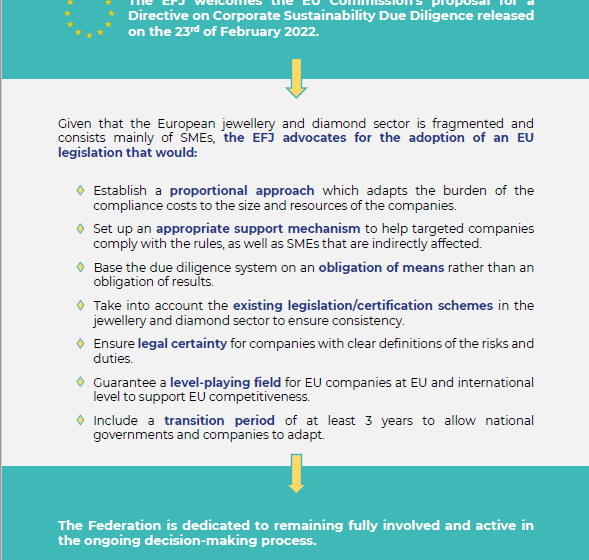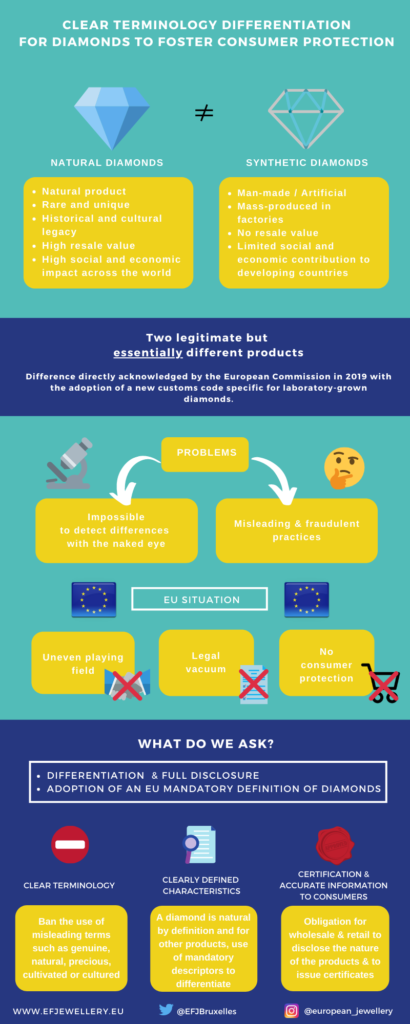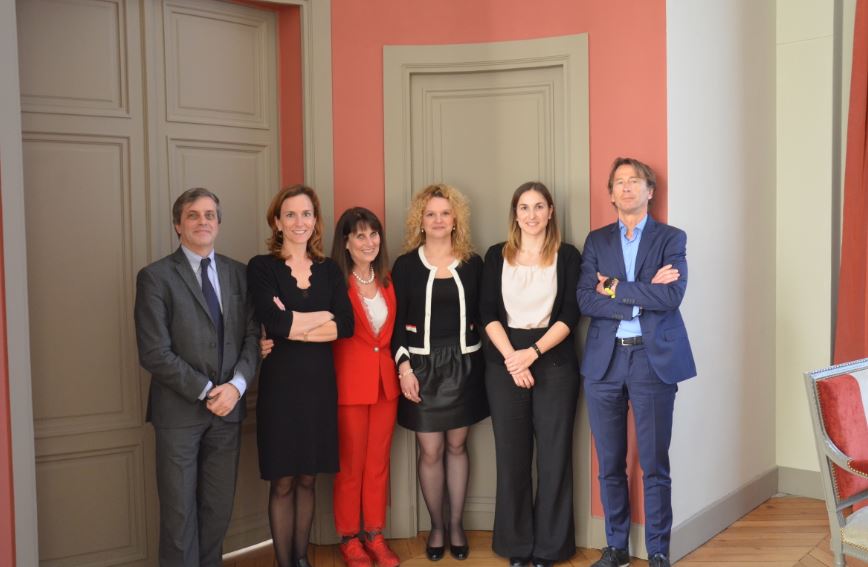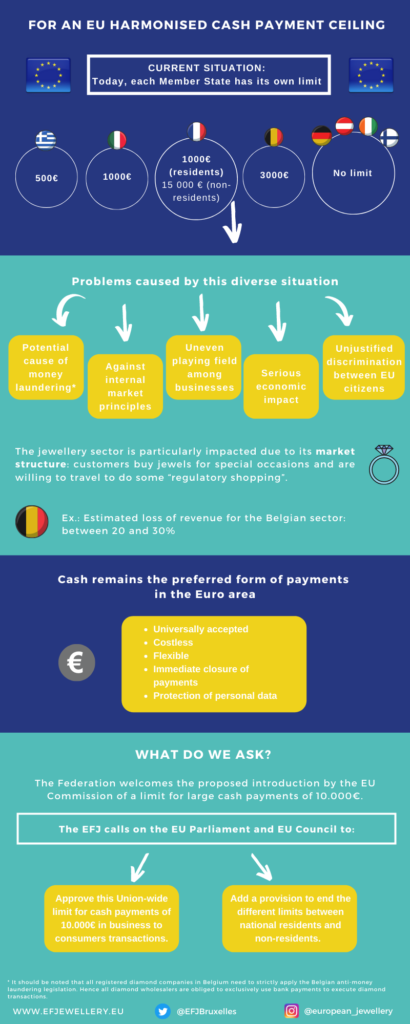The European Federation of Jewellery regrets that European jewellery products do not benefit from the free circulation, as several obstacles remain within intra-EU trade for articles made from precious metals.
Indeed, the principle of mutual recognition does not allow the free movement of jewellery articles within the EU, due to many exceptions brought forward by Member States for reasons of public safety, public health and protection of consumer interests. These exceptions introduce additional requirements for the imported products to comply with before being placed on the market.
In that context, the Federation applauds the European Commission’s willingness to fully harness the potential of the single market by enforcing existing single market rules and removing Member States-level barriers, as announced in the Commission’s communication on “the Single Market at 30“.
- Introduction to the world of jewellery production
Each piece of jewellery usually bears two marks, one that identifies the operator (manufacturer/ importer) who first places the goods on the market, the other determines the purity/fineness of the precious metal.
The fineness can be placed on the piece, either by the operator himself or by an independent laboratory, which, before the piece is put on the market, analyses and marks it. In some EU countries it is compulsory for the purity to be determined by a laboratory. In others, the operator is enough.
The fineness mark affixed by a laboratory designated by the Public Administration of a Member State is usually called a guarantee mark, and it is a national mark that must be published in the Official Journal of the Member State in question. Each country has its own fineness marks for each precious metal.
- Why do we need harmonisation of precious metals?
There are currently 27 different national legal systems concerning articles of precious metals. This means that an operator who wishes to export to another EU Member State needs to get previous information on the sales conditions in that country. This is a complex and burdensome process as the operator needs to investigate on:
- the national fineness marks in the country of destination;
- the design requirements, if any, for the producer’s identification mark;
- whether or not it is compulsory to have the products sent to an independent laboratory or body for test and marking before being sold.
In addition, because of the coexistence of 27 different legal systems, there is no effective product surveillance in the market, which prevents, in practice, the detection of infringements. As a result, this leads to fraud channels, unfair competition and lower quality products.
This also leads to a decrease in intra-EU trade for European jewellery products, as legal uncertainty displaces investments to other countries and other sectors. For example, Spanish exports were traditionally directed towards the EU. The absence of harmonisation has inclined the trend towards third countries, especially the USA, and there is a growing trend towards sales in Israel, which occupies practically the same place as Germany.
- Where do the main costs of non-harmonisation lie?
The direct and indirect costs are due to the following:
- Finding information on the laws of the country of destination and any updates. The national authorities of the EU country of origin and the EU country of destination do not have the information available or if it is available, it only arrives after several weeks.
Indeed, the competent office of the national authority does not know the laws that each country has for each industrial sector. Therefore, they usually contact the jewellery association of the country of destination and obtain the legislation, which is usually incomplete and needs to be translated. This process takes 45 days on average. Besides, in some countries, like in Spain, each consultation requires a prior payment due to the economic situation.
If the operator is a sufficiently large company, they can also hire legal experts to inform them on the sales conditions in the country of destination. However, small operators are unable to invest in the previous costs and are therefore discouraged from selling in the EU. This often leads to a loss of interest for the jewellery field or to maintain the production at a small, national level instead of expanding to external markets.
Furthermore, although Product Contact Points (PCPs) have been set up in each EU country, as required by the Regulation 2019/515 on the mutual recognition of goods, this has not improved access to information. In fact, the links provided by EU country are not user-friendly, as it is difficult to find any information on the requirements for articles of precious metals and the information is only available in the language of the country concerned.
- Non recognition of precious metals fineness marks that are legal in one Member State by another Member State. Indeed, for some countries, operators cannot sell their products in another country, before their articles are checked and stamped by the laboratories of the country of destination. This generates additional costs and delays in the delivery of the products.
For example, in Italy, legally manufactured precious metals articles cannot be placed on the market of 18 EU countries unless they have passed an inspection and stamping at laboratories in the countries of destination. This results in additional costs for analysis and marking, costs for delays (several weeks) in the delivery of articles, damages to finished products due to product handling and additional marking. For some product typologies, the cost of this control is estimated to be as high as 10% of the added value. There are also costs for security and product insurance. Furthermore, the sampling of batches of goods carried out at the laboratories is not done on a statistical basis with regard to batch homogeneity. Internationally recognised methods of precious metal analysis are destructive. Often for these analyses, these laboratories do not use the internationally recognised methods (ISO/CEN) but other non-destructive methods, which are therefore less reliable. Finally, the analysis laboratories are in many cases not accredited according to international standards (i.e.: ISO/IEC 17025). Moreover, in the event of non-compliance, there is no possibility for the operator to carry out counter-evidence and therefore the operator must resort to the ordinary justice of the country of destination. An operation that obviously due to costs (also for the immobilisation of the goods) and time is never followed by the operator who prefers to have the goods returned.
- Fineness tolerances for precious metals vary from country to country. Being a high-value precious metal sector, even small percentages of variation affect the final cost of the product.
- Why do we urgently need an EU regulation ensuring the free circulation of articles of precious metals?
The lack of harmonisation generates high costs.
For example, based on a consultation with 250 production units of different types, it is estimated that in Spain, with respect to the EU, there is a loss of 23% of market share due to the absence of harmonisation, which represents some 51,52 million €. Furthermore, if there were imminent harmonisation, Spain would also gain in brand and image which would increase sales in third countries, adding 18% more to Spanish exports.
In Romania, independent artists and SMEs on the field of contemporary jewellery have a considerably low economic strength due to the difficult and costly procedures to trade within the EU. Having a harmonised legislation at the EU level would lead to a significant increase of up to 20% in their businesses.
A harmonised legislation for the entire European market, compatible with national trade laws, would allow easier understanding of the legislative framework and more companies to comply with the norms in their activities. It would also enable to decrease the dangers of the illegal/black market of jewellery, as well as reducing the unfair competition for companies complying with the legislation.
Consumer protection must be guaranteed by market surveillance by the Member States and not by additional certification systems which are unable to provide guarantee, from a scientific/statistical point of view, of the precious metal content, of the presence within the established limits of substances potentially dangerous (e.g. nickel) or of the conformity of the diamonds and stones present on the object with respect to those declared.
Legal certainty leads to greater economic investment and greater efficiency in the fight against fraud. Harmonisation will result in higher product quality, greater guarantees for the consumer, greater clarity for the operators and fair competition.
This will favour the growth of smaller companies and thus better distributed economic growth. Therefore, only European legislation, compatible with national trade laws, could solve this situation.






